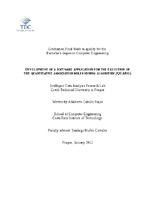Mostrar el registro sencillo del ítem
Development of a software application for the execution of the quantitative association rules mining algorithm (QUARG)
| dc.contributor.author | Cubillo-Rojas, Adalberto | |
| dc.date.accessioned | 2015-03-12T19:16:56Z | |
| dc.date.available | 2015-03-12T19:16:56Z | |
| dc.date.issued | 2012 | |
| dc.identifier.uri | https://hdl.handle.net/2238/3942 | |
| dc.description | Proyecto de graduación (Bachillerato en Ingeniería en Computación) Instituto Tecnológico de Costa Rica, Escuela de Ingeniería en Computación, 2012 | es_CR |
| dc.description.abstract | Nowadays, the use of the information and communication technologies has resulted in storage of large amounts of data every day. That data can be used later as a source of knowledge to enterprises and organizations through the use of data mining techniques. One of the most frequently applied data-mining techniques is association rules. This is due of their ability to identify interesting relationships among huge amounts of data. But for certain types of data it often results in a computationally expensive algorithm. According to F. Karel [3], the association rules are understood as an implication X → Y in a transactional database, each of which contains a subset of items or attributes, where the item sets X and Y are disjoint. The left side of this implication is called the antecedent, and the right side is referred to as consequent. An example of this is: having the statement “if a customer buys a toothbrush, then she also probably buys toothpaste” then the association rule can be written as: {toothbrush}→{toothpaste}. In 2009, Filip Karel proposed and verified in his doctoral thesis an efficient way to obtain this knowledge using ordinal association rules. He developed an alternative approach to the quantitative association rule mining (QUARG). This document intends to present the QUARGsoft application, which main objective is to develop an efficient implementation of the quantitative association rules mining algorithm (QUARG) into a web application. The document starts introducing the description of the problem with the details of how works the QUARG genetic algorithm and the role of the Intelligent Data Analysis Research Laboratory within this project. Then, the document introduces the generalities of the project and shows how the problem was solved using open source tools during the development of it, within the important elements are the taken design, the developed pseudo-code, and the source code of the application. All of this let the reader to have an comprehensive view of the application's functionalities. Finally, some runtime comparison results, between the experimental scripts in Matlab and the developed application in Java, are shown. Which denote the accomplishment of the project's main objective and concludes that the QUARGsoft application improves the Filip Karel's experimental scripts reducing the runtime of the algorithm more than 50% | es_CR |
| dc.description.sponsorship | Intelligent Data Analysis Research Lab Czech Technical University in Prague | es_CR |
| dc.language.iso | es | es_CR |
| dc.rights | acceso abierto | es |
| dc.subject | Czech Technical University in Prague Intelligent Data Analysis Research Lab | es_CR |
| dc.subject | Aplicaciones de software | es_CR |
| dc.subject | Java | es_CR |
| dc.subject | Aplicaciones web | es_CR |
| dc.subject | Bases de datos | es_CR |
| dc.subject | Algoritmos genéticos | es_CR |
| dc.title | Development of a software application for the execution of the quantitative association rules mining algorithm (QUARG) | es_CR |
| dc.type | proyecto fin de carrera | es |


